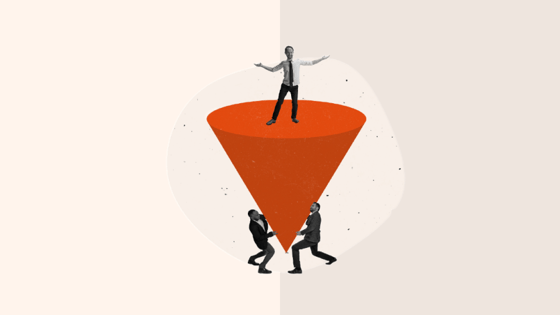
Pipeline Velocity: What is It + How to Measure & Accelerate
Are you losing leads due to an inefficient sales pipeline?
Imagine this: A new visitor comes to your website. They encounter an offer that compels them to provide their email address. In other words, that visitor just entered your sales pipeline. How long does it now take for that lead to become a smiling, satisfied customer?
And, once you have that number… how do you know if it’s fast enough to be profitable?
This post will go over all the basics of your pipeline velocity. We’ll discuss what this marketing metric is, how to calculate it, and how to improve it for your business.
5 Tips to Improve Pipeline Velocity
- Clearly define lead criteria
- Create a collaborative environment
- Reduce friction in the buyers’ journey
- Measure and track KPIs
- Create sales enablement content
1. Clearly Define Lead Criteria
There’s a common thought in sales that more leads always translates to more business. This line of thinking isn’t wrong, exactly, but it’s missing a key ingredient.
Related Read: 7 Reasons More Website Traffic Can Actually Hurt Your Business
More of the right leads always translate to more business. However, more of the wrong leads will clog up your pipeline and waste your reps’ time, slowing things down for everyone. The first trick to increasing your pipeline velocity is to ensure that only quality leads enter your pipeline.
How can you avoid wasting time pursuing or following up on poor-quality leads?
Examine your lead magnets. Do they work like magnets– do they simultaneously attract your ideal customer while simultaneously repelling poor-fit leads?
Create your offers with intention to ensure your lead magnets meet your ideal customer where they are in their buyer’s journey. What offer will make your ideal buyer perk up their ears and say, “I need that! It was made for me!”
2. Create a Collaborative Environment
In many businesses, siloes are accepted as par for the course. Marketing, sales, customer relations, and product teams often work in isolation, striving to reach their own goals without truly understanding how pulling a string in marketing affects the metaphorical sales machine all the way down in customer relations.
Maintaining siloed departments is the best way to do double the work and see half the results. So, what's the answer?
Implement the approach of a growth team.
A growth team takes a cross-functional approach to customer acquisition. The growth team brings together leaders from every stage in the funnel to build a unified strategy and focus efforts to improve performance and customer acquisition.
Embracing collaboration across teams will also help with the first tip on this list. Better communication from marketing to sales and vice versa creates a stronger understanding for both teams regarding what makes a quality lead and how to better target those potential customers.
3. Reduce Friction in the Buyers’ Journey
Better communication and collaboration between teams can help smooth out handoffs between stages of the buyers’ journey. Still, those handoffs likely aren’t the only sticking points in your funnel.
Examine your pipeline carefully. Where are leads dropping out? Go through those parts of your funnel with a fine-toothed comb to identify the sticking points causing leads to abandon your sales process.
For example, are you asking for name, company size, budget, and email on a conversion form where simply name and email would do?
Examining your entire site for friction points by hand can be challenging, time-consuming, and inefficient. As a result, you might want to employ the help of a tool like our Growth Grader to help you out.
Our Growth Grader tool gives you the ability to visualize your funnel’s performance on all six levers of growth. With the help of this tool, you can more easily identify friction points in your buyers’ journey and take steps to counter them.
4. Measure and Track KPIs
How many of us have heard the marketing truism, “if you can’t measure it, you can’t improve it”?
Apply this standard teaching to your sales pipeline. Of course, in this post, we’re talking about one specific metric, pipeline velocity, but that is not the only metric you should be tracking. In fact, to increase your pipeline velocity, you’ll need to keep your finger on the pulse of several other metrics.
Establish KPIs across the right metrics for your business. Then, set up processes to regularly check in with those KPIs and track your progress.
Unsure of which metrics to begin tracking? Check out these to start:
- Number of SQLs
- Average deal size
- Win rate
- Sales cycle length
Tracking and working to improve the right metrics is the key to achieving profitable, scaleable growth.
5. Create Sales Enablement Content
Even if you have your KPIs sorted and your buyers’ journey dialed in, your pipeline velocity might not be as speedy as it could be. Why? Because your salespeople are human and they can only do so many things at once. Our last tip for accelerating your pipeline velocity is creating sales enablement content.
Related Read: 5 Tips to Optimize Your Sales Process for Faster Conversions
Sales enablement content can help your sales reps address concerns, answer common questions, and convert more leads into customers. Creating this type of content can take some of the burden off your sales reps and help guide leads through your funnel more efficiently.
Some examples of sales enablement content you can explore include:
- Video case studies
- Buying guides
- Build and price tools
- Sharable sales decks
Any asset your sales team can share with prospects to overcome objections and help those leads come to a decision more quickly can be a valuable asset for your business.
Beyond Pipeline Velocity: Improve All Your Marketing KPIs
Understanding and improving pipeline velocity is one way to increase revenue and grow your business. However, you need more than pipeline velocity to drive profitable, sustainable growth.
To maximize your efforts and supercharge your growth, you need to excel in all six levers of growth—from Awareness to Referrals and everything in between. To increase your pipeline velocity, maximize customer retention, and more, you need to understand where leads and customers encounter friction in your buyers’ journey.
Our free Growth Grader tool can help you quickly identify what's working best and what is causing friction within your buyer journey. Then, you can systematically track increases against goals all within this one tool.
Access the Growth Grader for free today and get started!






